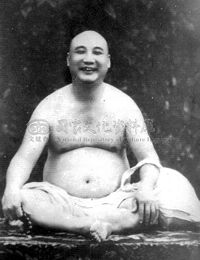Views
There were at least two Chinese monks known by this name in the 20th century.
Contents |
Cíháng (1) 慈航 (1869-1919)
Cíháng 慈航 (1869-1919)
|
| Notable Associates:
|
|
Short bio.
Biography
Cíháng ordained at the age of 17 suì 歲 (1885) at Qīngcháo Temple 清潮寺. He was known as Cíháng "Compassionate Boat" because he worked hard for the people around his temple, this work including running a ferry for them to get across the lake upon which the town was located.
Notes
References
- Yú Língbō 于凌波, ed. Xiàndài Fójiào rénwù cídiǎn 現代佛教人物辭典 (A Dictionary of Modern Buddhist Persons), 2 vols. Taipei: Foguang, 2004. Pp. 2.1284b-1285a.
Cíháng (1) 慈航 (1895-1954)
Cíháng 慈航 (1895-1954)
|
| Notable Associates:
|
|
Short bio.
Biography
Cíháng's mother died when he was 10 suì 歲, and his father died two years later. Cíháng was then raised by an aunt and uncle. As a young man he learned his uncle's trade, which was the making of monastic robes. During this time he visited many temples, and eventually decided to become a monk. He tonsured under Zìzhōng 自忠 in 1912, and then went to Néngrén Temple 能仁寺 in Jiāngxī 江西 to receive full ordination the following year.
From 1912 to 1927, Cíháng visited many famous centers of monastic learning and studied under Dìxián 諦閑, Yúanyīng 圓瑛, and Èlǎo 厄老.
In September of 1927 he became a student at the Mínnán Buddhist Seminary 閩南佛學院. At that time, Tàixū 太虛 (the abbot of the overseeing monastery) was often away. Later that winter, a conflict broke out between those running the monastery and one Xuécháo 學潮. Although Cíháng was not part of this fight, he was implicated in Xuécháo's group, and left the seminary voluntarily.
In the fall of 1928, Cíháng was asked by Zhú'ān 竺庵 to become abbot of Yíngjiāng Temple 迎江寺 in Ānqìng 安慶. By this point in his life, Cíháng had not received a great deal of education, but he knew that as abbot of the monastery he had to study. He began by assiduously studying Táng Dàyuán's 唐大圓 Lectures on Consciousness-Only (Wéishì jiǎngyì 唯識講義). He also established a night school at the temple for local orphans.
After a fire destroyed half of the temple complex in the first month of 1920, Cíháng retired from his abbacy and traveled to Hang Kong 香港, then Burma where he took up the abbacy of Lónghuá Temple 龍華寺 in Rangoon. He taught lectured there for two or three years. On Buddha's Birthday in 1933, several local lay Buddhists helped him establish a "Chinese Buddhist Studies Association" 中國佛學會, at which he and several lay people lectured.
Cíháng went on a lecture tour in Eastern China in 1935. These lectures were later published by the World Buddhist Studies Center 世界佛學苑. Cíháng returned to Rangoon after the Second-Sino Japanese War began in the summer of 1937. Four several months in 1939, Cíháng joined Tàixū and others on a tour of Buddhist sites in South and Southeast Asia. For the next ten years, Cíháng taught in the overseas Chinese Buddhist communities in SOutheat Asia.
In 1947, Cíháng was invited by Miàoguǒ 妙果 to come to Táiwān 台灣 to set up a Buddhist Seminary 佛學院. Cíháng arrived in October of that year. Although he was intially discouraged by the poor conditions at Yuánguang1 Temple 圓光寺, he persevered and they soon established the Taiwanese Buddhist Seminary 台灣佛學院. At first they had only few nuns, lay people, and monks, but in the fall of 1949, many famous monks from the mainland came to Taiwan, and sought to teach and study at the Seminary. The resources of their temple would only let them accommodate so many refugees. This led to some conflicts with the temple, and negotiations. Cíháng continued to work for the refugee monks from the mainland.
On New Year's Eve 除夕 of 1953 Cíháng told his disciples that he would be "leaving" (i.e. passing away) by the fourth month of the following year. He passed away on May 6, 1954 at the Maitreya Hermitage 彌勒精舍 in Xìzhǐ 汐止.
As reported in Welch[1], Cíháng's body was famously exhumed on May 19, 1959 and when he body was found to be more or less intact, he was mummified according the practices of the Chinese Buddhist tradition.[2] He was the first monk to be preserved in this way in Taiwan.Important Works
Notable Students
Notes
- ↑ Welch, Holmes. The Practice of Chinese Buddhism: 1900-1950. Cambridge: Harvard University Press, 1967. Pp. 343-344.
- ↑ A slideshow of the mummification process can be viewed here.
References
- Shì Dōngchū 釋東初. Zhōngguó Fójiào jìndài shǐ 中國佛教近代史 (A History of Early Contemporary Chinese Buddhism), in Dōngchū lǎorén quánjí 東初老人全集 (Complete Collection of Old Man Dongchu), vols. 1-2. Taipei: Dongchu, 1974 Pp. 2.927-931.
- Yú Língbō 于凌波, ed. Xiàndài Fójiào rénwù cídiǎn 現代佛教人物辭典 (A Dictionary of Modern Buddhist Persons), 2 vols. Taipei: Foguang, 2004. Pp. 2.1285b-1288b.

